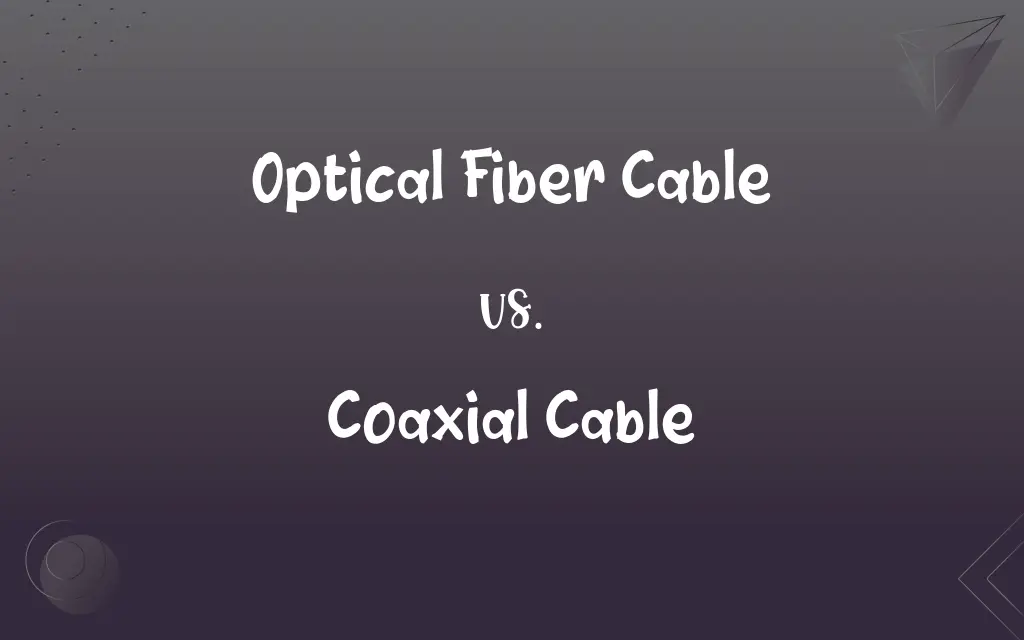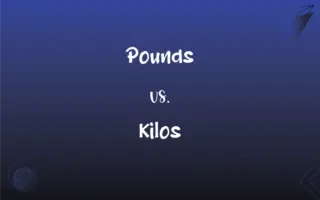Optical Fiber Cable vs. Coaxial Cable: What's the Difference?
Edited by Harlon Moss || By Janet White || Published on February 24, 2024
Optical fiber cables use light to transmit data at high speeds over long distances, while coaxial cables use electrical signals over copper conductors.

Key Differences
Optical fiber cables consist of a core and cladding that use light to transmit data, allowing for high-speed data transmission over long distances with minimal signal loss. Coaxial cables, in contrast, are composed of a central copper conductor surrounded by insulation, a metallic shield, and a plastic covering, transmitting data through electrical signals.
The key advantage of optical fiber cables is their high bandwidth and capacity to carry large amounts of data at speeds much faster than coaxial cables. Coaxial cables, while slower in data transmission compared to fiber optics, are widely used for their durability and effectiveness in a range of applications, including cable television and internet services.
Optical fiber cables are less susceptible to electromagnetic interference and signal attenuation, making them ideal for long-distance communication. Coaxial cables, however, are more prone to signal loss over long distances and can be affected by electromagnetic interference.
In terms of installation, optical fiber cables are more fragile and require careful handling and specialized equipment. Coaxial cables are more robust and easier to install, with greater flexibility and lower cost.
Fiber optic technology is increasingly preferred in modern telecommunications and network connections due to its higher bandwidth and longer transmission distances. Coaxial cables remain prevalent in many conventional systems and are favored in scenarios where cost or environmental factors are a consideration.
ADVERTISEMENT
Comparison Chart
Transmission Medium
Light signals.
Electrical signals.
Bandwidth
High bandwidth, allowing faster data transmission.
Lower bandwidth compared to optical fiber.
Interference
Less susceptible to electromagnetic interference.
More prone to electromagnetic interference.
Installation
Requires careful handling, more delicate.
Easier to install and more robust.
Use Cases
Ideal for long-distance, high-speed data transmission.
Commonly used for cable TV, internet, and shorter distance data transmission.
ADVERTISEMENT
Optical Fiber Cable and Coaxial Cable Definitions
Optical Fiber Cable
Transmits data as light signals through a glass or plastic fiber.
The company upgraded to optical fiber cables for faster internet speeds.
Coaxial Cable
Enclosed by an insulating layer, metallic shield, and plastic covering.
The coaxial cable's design helps protect against signal interference.
Optical Fiber Cable
Ideal for long-distance and high-speed data transmission.
To support the growing data needs, optical fiber cables were installed.
Coaxial Cable
Suitable for cable television and internet connections.
Most homes in the area use coaxial cables for internet access.
Optical Fiber Cable
Used in modern telecommunications and high-speed networks.
The data center's backbone was built using optical fiber cables.
Coaxial Cable
Preferred for its durability and flexibility in various environments.
Coaxial cables were used due to their robustness in outdoor settings.
Optical Fiber Cable
Less prone to electromagnetic interference.
Optical fiber cables were chosen for their immunity to electrical noise.
Coaxial Cable
More susceptible to signal loss over long distances.
For longer runs, the signal in coaxial cables needed amplification.
Optical Fiber Cable
Characterized by high bandwidth and minimal signal loss.
Optical fiber cables enabled efficient data transfer across continents.
Coaxial Cable
Uses a central copper conductor to transmit data electrically.
Coaxial cables were installed for the cable TV setup.
FAQs
What are coaxial cables commonly used for?
For cable television, internet services, and audio transmission.
How do optical fiber cables transmit data?
By using light signals.
Are coaxial cables susceptible to electromagnetic interference?
Yes, they are more prone to interference than optical fibers.
What is a coaxial cable?
A type of cable with a central copper conductor used for transmitting electrical signals.
What makes coaxial cables robust and flexible?
Their layered structure, including an insulating layer and metallic shield.
What is an optical fiber cable?
A cable that transmits data as light signals through glass or plastic fibers.
Why are optical fiber cables preferred for long-distance transmission?
Due to their high bandwidth and minimal signal loss.
What is the main advantage of optical fiber over coaxial cables?
Higher data transmission speeds and less susceptibility to interference.
How do optical fiber cables handle signal interference?
They are highly resistant to electromagnetic interference.
Can coaxial cables be used for internet connectivity?
Yes, they are widely used for broadband internet connections.
Do optical fiber cables have a higher bandwidth than coaxial cables?
Yes, optical fibers offer significantly higher bandwidth.
Is installation of optical fiber cables more complex than coaxial cables?
Yes, it requires specialized equipment and handling.
Are optical fiber cables used in residential internet connections?
Yes, they are increasingly used for high-speed residential internet.
What kind of maintenance do coaxial cables require?
Regular checks for damage, corrosion, and loose connections.
Do optical fiber cables provide a secure transmission?
Yes, they offer more secure data transmission due to their resistance to tapping.
What is the major drawback of using coaxial cables for long distances?
Signal loss and the need for signal amplification over long distances.
Are optical fiber cables expensive compared to coaxial cables?
Generally, yes, due to their advanced technology and installation costs.
What is the durability of coaxial cables?
They are durable and suitable for a variety of environmental conditions.
Can coaxial cables be used for audio and video transmission?
Yes, they are commonly used in audio and video applications.
Can coaxial cables carry digital signals?
Yes, they can transmit both analog and digital signals.
About Author
Written by
Janet WhiteJanet White has been an esteemed writer and blogger for Difference Wiki. Holding a Master's degree in Science and Medical Journalism from the prestigious Boston University, she has consistently demonstrated her expertise and passion for her field. When she's not immersed in her work, Janet relishes her time exercising, delving into a good book, and cherishing moments with friends and family.
Edited by
Harlon MossHarlon is a seasoned quality moderator and accomplished content writer for Difference Wiki. An alumnus of the prestigious University of California, he earned his degree in Computer Science. Leveraging his academic background, Harlon brings a meticulous and informed perspective to his work, ensuring content accuracy and excellence.







































































